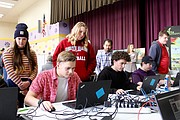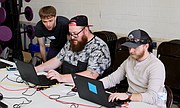Don't be a blockhead, learn about lead
KELLOGG — It certainly isn’t a new concept to get students more engaged through the use of video games in the classroom. What ’90s baby doesn’t remember playing “The Oregon Trail” in elementary school and learning about which one of your friends would last the longest in a trek across the heartland of 1848 America (in hindsight, probably not the lesson our teachers were going for, but still)?
As technology has increased considerably since then, so have the methods in which teachers engage their students. It only makes sense to incorporate education into what kids find fun, so where do you start?
For Panhandle Health District environmental health specialist Val Wade and some ambitious University of Idaho Art and Architecture students, the answer is that you build on something that kids are already familiar with.
With the overall goal of increasing the awareness of lead exposure among children in grades third through sixth, the PHD/UI collaborative has worked over the last year to create a program to do just that through the use of the popular video game — Minecraft.
For those unfamiliar, Minecraft is a sandbox style crafting game created in 2011. Depending on the game mode, players are placed into a procedurally generated blocky 3D world where they are free to roam and collect resources with the overall goal of constructing (or destroying) anything they wish.
Because of this freedom the game allows and the familiarity students may already have with it, using Minecraft as a platform to create the lead awareness game was an easy decision.
In a news release by Kate Keenan with the U of I College of Art and Architecture, she explains that the task of creating the game — tentatively titled “Lead Ed” — fell to five U of I seniors in the college’s Virtual Technology and Design Program.
Under the guidance of VTD Research Assistant Professor Roger Lew and Wade — Megan Schleich, Jared Christiansen, Garret Lowe, Austin Braymen and Dylan Luchini have worked to make the game a reality (Braymen and Luchini have since graduated).
“They took advantage of a modification in Minecraft,” Keenan said. “The students then built an environment that mirrors the Silver Valley — mines, mountains, all-terrain vehicles and all — and developed a storyline that sends players on a quest to determine why their friend is sick.”
The Shoshone News-Press editorial staff had the opportunity to try out the beta version of the game at the Environmental Science & Health Fair in Kellogg on April 11 and it was clear that the group has put a lot of effort into the project.
Players can interact with a slew of non-player characters and the physical world around them, all-while avoiding lead exposure (shown by an “exposure” or health bar of sorts that fills up after prolonged contact with lead) and completing quests. If the player’s exposure levels get too high, they can lower them by visiting any sink in the game to “wash up” and remove the lead. The game also stresses lead exposure prevention by having the player wear certain protective clothing when in areas with high lead concentrations and practicing healthy eating habits.
“When children playing the game … accompany their sick friend to the hospital, the doctor asks some probing questions. He learns his patient recently swam in Lake Coeur d’Alene and has a dad who works in the mines, so he sends the player on a mission to collect soil and water samples — from the father’s work boots and the lake,” Keenan said of the game’s opening quests.
In an interview Keenan did with co-creator Megan Schleich, Schleich said she hopes that this starting quest will result in increased empathy and an experience of emotional connection.
“At that age, kids are developing empathy from a psychological standpoint,” she said. “And the main character is the player running through the world, so children get to put themselves in the game, helping their friend get better.”
With the goal of keeping the game not only fun, but also accurate, PHD has offered guidance every step of the way in terms of how lead affects the human body and where it can be found.
While the game is still having some bugs shaken out, Wade is hopeful that PHD will be able to introduce the game to Silver Valley classrooms in the not-so-distant future.
Lowe told Keenan that he hopes the game will “have a tangible impact by teaching children safe practices in a risk-free environment.”
“I’ve always wanted to use video games as a way to influence people’s lives for the better and this is a good outlet to put that into practice,” he said.
For more information, contact Roger Lew at rogerlew@uidaho.edu or Val Wade at vwade@phd1.idaho.gov.





